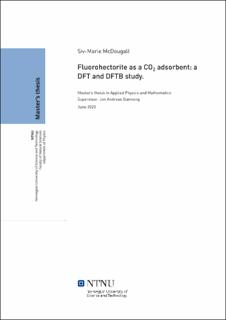| dc.description.abstract | I denne oppgaven gjøres beregninger med tetthetsfunksjonalteori (DFT) og tetthetsfunksjonalteori tight binding (DFTB) på leirematerialet fluorhektoritt for å finne hvilke kationer som passer best for interkalasjon av CO2. Med DFT blir utvekslingskorrelasjonsfunksjonalen GGA revPBE i den generaliserte gradientapproksimasjonen brukt. Med DFTB er to forskjellige Hamiltonier brukt, SCC-DFTB og GFN1-xTB. Kationene som blir undersøkt er Li+, Na+, K+, Rb+, Cs+, Be2, Mg2+, Ca2+, Ba2+ og Ni2+.
Resultatene viser at reaksjonenergien øker når kationet er posisjonert over det sekskantede hulrommet og ikke inni. Dette er mulig blant annet når det interkalerte kationet er for stort til å få plass inni det sekskantede hulrommet. Dessuten ligger CO2 oftest parallell til leireoverflaten. Med SCC-DFTB sveller leiren for økende mengder CO2. For kationer i gruppe I er større kationer tettere bundet til CO2. Med GFN1-xTB minker reaksjonsenergien med økende mengder CO2. Samtidig øker også X--O-bind-ingen. Tendensen er at større kationer binder CO2 bedre. Veldig små strekkvibrasjoner for CO2. i GFN1-xTB betyr en større sannsynlighet for at en CO3-gruppe har blitt dannet, spesielt når også C--O-distansen er liten. Dette gjelder i størst grad for Ca-Fh and 2Cs-Fh. Med økende mengder CO2 minker C--O-lengden, noe som betyr at CO2-bindingen svekkes. | |
| dc.description.abstract | In this thesis, a density functional theory (DFT) and density functional tight binding (DFTB) study is conducted to see how different cations will bind to CO2 in fluorohectorite, in an attempt to predict whether they can be used in fluorohectorite for CO2 storage. With DFT, the GGA revPBE exchange correlation functional is used. With DFTB, two different Hamiltonians are used; SCC-DFTB and GFN1-xTB. The cations used are Li+, Na+, K+, Rb+, Cs+, Be2, Mg2+, Ca2+, Ba2+ and Ni2+.
The results show that for both models the reaction energies seem to increase when the cation is not residing in the hexagonal cavity, but above it and more placed in the interlayer. The cation can not reside in the hexagonal cavity when the intercalated cation is too large. Also, CO2 is likely to be parallel to the clay surface. Using the SCC-DFTB parametrization, the clay swells with increased amounts of CO2. For one group I cation, larger cations are more tightly bound to CO2. Using the GFN1-xTB parametrization, the reaction energy decreases when adding more CO2 to the cations. At the same time, the cation--oxygen bond length increases. The tendency is that larger cations bind CO2 better. Very small frequencies means a greater likelihood for a structure with CO3 in GFN1-xTB, especially seen in the context of a short C--O distance, which especially applies to Ca-Fh and 2Cs-Fh. With increased amounts of CO2, the C--O distance decrease, which means a weakening of the CO2 bond. | |
